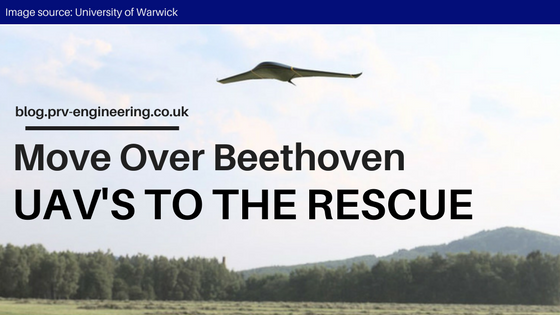
A glimpse into the future of mountain rescue could mean replacing the image of our furry friend, the St Bernard. No surprise really as technology is forever advancing and with that, an unmanned aerial vehicle (UAV) made from carbon fiber with a 2.2 meter wingspan.
A team of students at the prestigious University of Warwick School of Engineering in Coventry, England, has designed an unmanned aerial vehicle. The core concept is to deliver immediate aid and equipment to people in need before a rescue team arrives. These UAV’s will essentially be the first responders.
Creating Unmanned Aerial Vehicles Using Additive Manufacturing
In a real-life product development and government-backed program called, Horizon AM, seven engineering students embarked on this project. The program is aimed at leveraging additive manufacturing techniques in an aerospace environment.
With a large format 3D printer at their disposal, the team had the opportunity to design something special. They needed an unmanned aerial vehicle specifically designed for long-distance flight and a heavier payload. Current UAV’s like the ones from Zipline, a US startup company, are not purpose-built for rescue missions. However, they still do great work by delivering plasma and blood to Rwandan hospitals.
The design process was a tricky one trying to balance travel range and payload capacity. They decided to overhaul the traditional fuselage, which they claim is mere deadweight without creating any significant lift. The end result was pretty amazing as they developed a ‘blended-wing’ body where the fuselage is built into the wing. It essentially becomes one part which generates significantly more lift than just the wings.
The design has no stabilising tail which required some careful calculations. Using Autodesk Fusion 360 made this possible as it offers all sorts of simulation and shape optimisation. They had to accurately determine the drag ratio, lift figures and shape optimisation to make the UAV stable and lightweight while still able to fly long distances with a heavier payload.
Early Prototype Ups-and-Downs
Before deciding on the final design, the team built a prototype with a 1-meter wingspan. It was made from foam with batteries and radio equipment attached to see how it would fly (or wouldn’t fly in this case). The flight only lasted 21.2 seconds as it was too heavy to fly at speeds low enough for the team to track.
They needed a bigger wingspan to generate more lift which resulted in the UAV getting a 2.2 meter (7.2 ft) wingspan. It has multi-imaging cameras and an antenna tracking system to maintain contact. The UAV also features two control systems – a traditional manual transmitter for takeoff and landing; and an autopilot system controlled by modified open-source software.
The student team worked under the guidance of Simon Leigh, Associate Professor at Warwick, who specialises in additive manufacturing. They would 3D-print reusable moulds of the UAV body parts and infuse them with resin to create strong, yet light carbon fiber for the final product. 3D printing the moulds took about a month and infusing the parts with resin also proved rather challenging but certainly worth the effort.
Applications Of The Rescue Unmanned Aerial Vehicle
The main function of this advanced unmanned aerial vehicle will be to search for casualties on a mountain and land next to them by parachute to deliver lifesaving supplies. A great concept is to make the parachute from emergency space blankets for the injured person to use. Additional equipment could also be attached to the drone specific to each emergency.
The customised software can tailor the payload and calculate the weight to determine the right center of gravity. For this, the team cataloged supplies they wanted on the drone and worked out where they will fit best on the frame. They used Autodesk additive manufacturing software to optimise the UAV design to be 3D print friendly and reduce weight.
Ed Barlow, the project lead, aimed to give the UAV a payload capacity of 5 kg (11 pounds) and a range of 80 km (49.7 miles). As it stands, that is considerably farther than current UK regulations for this type of unmanned aerial vehicle allow. According to Simon Leigh, it’s a challenge to manage the many layers of regulations applied by the UK’s Civil Aviation Authority (CAA) and the wireless communications regulations from Ofcom. They feel the CAA wants to build airspace for small UAV’s (SUAV’s) which is where Amazon delivery drones would operate. The same will apply to the airspace the rescue drone will identify with.
Final Thoughts
We truly are at the cutting edge of technology where this unmanned aerial vehicle could potentially save countless lives. But, as with all great engineering innovations, there is always a chance someone will abuse the technology. Can we really blame those who are against advanced artificial intelligence and autonomous technology? What are your thoughts on this? Please leave your comments in the section below or connect with us on Facebook or Twitter using #techviewPRV.
PRV Engineering manufactures for a range of industries including automotive, rail, construction, aerospace and defence among others. If you have any inquiries please visit our website or give us a call on 01495 707964.
This site uses Akismet to reduce spam. Learn how your comment data is processed.


 Mail:
Mail: 




Leave a Comments